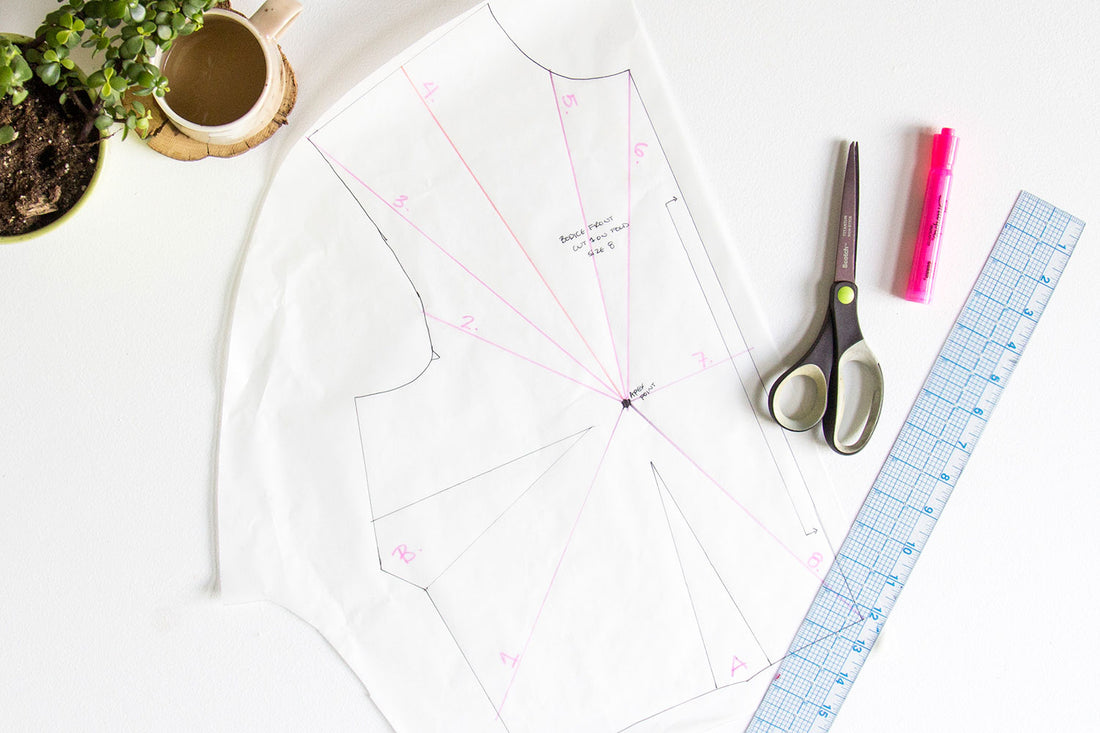Oh goodness, it seems like forever since I last wrote a post for the blog! Sometimes, life simply comes and throws you a bit off course, doesn't it? Well, I hope you are as excited as I am for this particular tutorial!
I have personally found that I gravitate towards a specific type of dart placement in my garments. I typically enjoy having at least two bodice darts in the front of the tops or dresses and at least one in the back. For the front of my bodices, I also like having at least one of the darts coming up from the waist. These are all of course personal preferences and you may find that you enjoy darts placed in a completely different area!
Sometimes, however, I will find a pattern that I adore, but the dart placement feels a bit...off for me. Luckily, if after I muslin a bodice of a pattern I find that I DON'T like the dart placement, there is an easy solution to moving those darts around!
Ok, Let's Get Started!
You'll want to gather some supplies first and foremost! You'll want to grab the following:
- A traced copy of your Bodice Pattern
- A ruler
- Paper Scissors
- A Highlighter
- Tape
- Additional Paper
- Coffee or Tea (Gotta have that bit of comfort!)

I have gone ahead and marked all of the common darts you might find on a front bodice pattern. Feel free to experiment with your bodice using the pointers below and see what combos of darts you like! My favorite darts include the Center Front Waist (8), Mid Armhole (2), Center Front Neck (6), and the French Dart (1)!
- A. Waist Dart
- B. Side Dart
- French Dart
- Mid Armhole Dart
- Shoulder Tip Dart
- Mid-Shoulder Dart
- Mid-Neck Dart
- Center Front Neck Dart
- Center Front Bust Dart
- Center Front Waist Dart
Feel free to draw in all of the darts onto your traced bodice pattern, or pick one at a time to play around with!

No matter what you decide to do, we will all start this process off in the same way: taping up our current darts (for me this is darts A & B).


At this point, your paper pattern should stand in a more 3-dimensional form which would be wonderful if we were making our final garments out of tracing paper. Since that kind of garment would inevitably crumble in the rain, we are now going to transfer out all of that excess 3-D-ness by choosing one of our other lines and cutting it open all the way to the apex!

I chose my favorite dart to do this: the French Dart of course!

Once you have slashed your new line open, flatten your pattern piece out in front of you- doesn't it look pretty? You'll also want to slide a spare piece of paper underneath your new dart opening and tape it down along the edges of the dart. It's hard to see my paper because it's white on top of a white table, but I promise it is there!


Once everything is all taped and secured, we will need to figure out where to end our new dart point. This is a super personal preference kind of location and highly depends on your specific bust. For me, I like to keep my bust point about 1-1.5” (2.5-3.8 cm) away from the apex point. I measured my original pattern's waist dart to see how far away from the apex it was located and it was exactly 1.5” (3.8 cm) away, so I stuck with that for my new dart. I can always change it later if I don't like that positioning.


You'll want to make sure you find the center point of your dart at the dart tip before marking your new dart end. Once you have that marked, draw out your dart legs! Your dart legs will end at either side of the line you cut and spread open.

Now connect those dots and you are 90% of the way to having a brand new dart for your pattern!

The last thing you'll want to do is to fold your dart closed and trim off the excess paper from the side. By doing this, you will ensure that you have the right amount of fabric in the dart itself to actually catch to the inside of your seam allowance.



The french dart legs almost look like a paper airplane.

Yay! You have successfully moved your darts to a new location! As always, it is best to sew up a muslin with these changes to ensure that the dart it hitting you where you intended. You may have to adjust the dart length of even direction a bit depending on your body and preferences, so making a muslin or toile is always a good idea!
Now, sometimes when you transfer out a dart, you might see that the dart has a really large width. Let me show you an example.
I closed up my new french dart and cut through my shoulder seam dart. As you can see, this width is REALLY big- six whole inches (15.3 cm). I am not sure if there is a rule out there about darts – at least not one that I can remember clearly – but 6” (15.3cm) is a large amount of fabric to try to take into one place.


If you ever run into a dart being too large the best solution is to ease that width out into another dart. That's exactly what I decided to do for this bodice top- I opened up my waist dart and immediately the shoulder dart reduced its width by nearly half! That's a heck of a lot and will be much easier to handle when sewing it all up!

Now I'm going to finish off my new dart placement in the same way that I did the french dart, except this time I am going to raise the dart end point to be 2” (5 cm) away from the apex. This is 100% a guess for me as I haven't worked with many shoulder darts, but the ones I have seen don't seem to come super close to the apex. Only the toile will tell!



Next I'll close that new dart up and true up the shoulder seam as it's gotten a bit off from the original line.


And lastly, I will cut through that new line to get that beautiful outer dart point!


Awesome, I am so excited to see what you all think of this project and how you utilize it in your next sewing project. It can be so much fun to move your darts around and experiment with new silhouettes and these tiny details :)


3 comments
Thank you. Very detailed and exactly what I needed.
Oh I am so happy to hear that I was able to share this in a clear and concise way :) I hope it helps!
Awesome clear explanation about dart manipulation. Thank you!